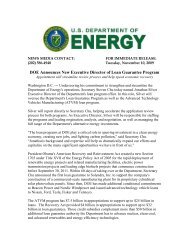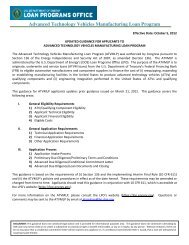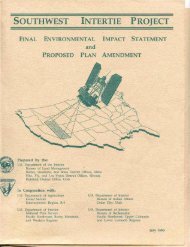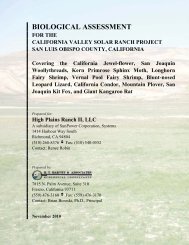Bureau of Land Management's Decision Record and Environmental
Bureau of Land Management's Decision Record and Environmental
Bureau of Land Management's Decision Record and Environmental
Create successful ePaper yourself
Turn your PDF publications into a flip-book with our unique Google optimized e-Paper software.
Jersey Valley Geothermal Development Project<br />
<strong>Environmental</strong> Assessment: NV063-EAO8-091<br />
3.11.2 <strong>Environmental</strong> Consequences<br />
3.11.2.1 Proposed Action<br />
Diesel fuel, lubricants, hydraulic fluids <strong>and</strong> drilling chemicals (drilling mud, caustic soda, barite,<br />
etc.), would be transported to, stored on <strong>and</strong> used by the project at the proposed drill sites (see<br />
Table 9). The project must conform to both federal <strong>and</strong> state requirements for h<strong>and</strong>ling these<br />
hazardous/regulated wastes materials. Typical <strong>of</strong> most construction projects, the storage <strong>and</strong> use<br />
<strong>of</strong> these materials may result in minor, incidental spills <strong>of</strong> diesel fuel or oil to the ground during<br />
fueling <strong>of</strong> equipment, filling <strong>of</strong> fuel storage tanks, <strong>and</strong> h<strong>and</strong>ling lubricants. Other incidental spills<br />
could be associated with equipment failures such as ruptured hoses. The project includes the<br />
development <strong>of</strong> a hazardous material spill <strong>and</strong> disposal contingency plan, as identified in the<br />
Utilization Plan, which would describe the methods for cleanup <strong>and</strong> abatement <strong>of</strong> any petroleum<br />
hydrocarbon (including petroleum contaminated soils) or other hazardous material spill.<br />
Table 9: Materials <strong>and</strong> Chemicals Commonly Used During Well Drilling<br />
Product Quantity Quantity Stored Hazardous<br />
Used Material?’<br />
Drilling Mud Gel (Bentonite Clay) 200,000 lbs 100 lb sacks on pallets No<br />
Salt (NaCl) 80,000 lbs 50 lb sacks on pallets No<br />
Barite (BaSO4) 12,000 lbs 50 lb sacks on pallets No<br />
Tannathin (Lignite) 2,500 lbs 50 lb sacks on pallets No<br />
Lime (Calcium Hydroxide) 2,000 lbs 50 lb sacks on pallets Yes<br />
Caustic Soda (Sodium Hydroxide) 1,000 lbs 50 lb sacks on pallets Yes<br />
Diesel Fuel 30,000 gals 6,000 gal tank Yes<br />
Lubricants (Motor Oil, Compressor Oil) 1,000 gals 55 gal drums Yes<br />
Hydraulic fluid 200 gals 55 gal drums No<br />
Anti-Freeze (Ethylene Glycol) 100 gals 55 gal drums No<br />
Liquid Polymer Emulsion (partially<br />
hydrolyzed polyacrylamide / 100 gals 5 gal buckets No<br />
polyacrylate (PHPA) copolymer)<br />
1. Hazardous materials are defined <strong>and</strong> regulated in the United States primarily by laws <strong>and</strong> regulations<br />
administered by the U.S. <strong>Environmental</strong> Protection Agency (EPA), the U.S. Occupational Safety <strong>and</strong><br />
Health Administration (OSI-IA), the U.S. Department <strong>of</strong> Transportation (DOT), <strong>and</strong> the U.S. Nuclear<br />
Regulatory Commission (NRC). Each has its own definition <strong>of</strong> a “hazardous material.’<br />
2. The material is characteristically hazardous due to its corrosivity<br />
3. The material is characteristically hazardous due to its flammability<br />
4. This material is considered orally toxic following ingestion.<br />
Well workover operations may involve placing a dilute mixture <strong>of</strong> hydrochloric (muriatic) <strong>and</strong><br />
hydr<strong>of</strong>luoric acids down the well, <strong>and</strong> would only transpire when <strong>and</strong> if needed. The amount <strong>of</strong><br />
dilute acid placed in the well bore (which can vary from 10,000 gallons to 50,000 gallons or<br />
more) is determined by calculating the amount <strong>of</strong> each type <strong>of</strong> mineral to be dissolved.<br />
- 73 -<br />
2<br />
2<br />
3<br />
3<br />
4







